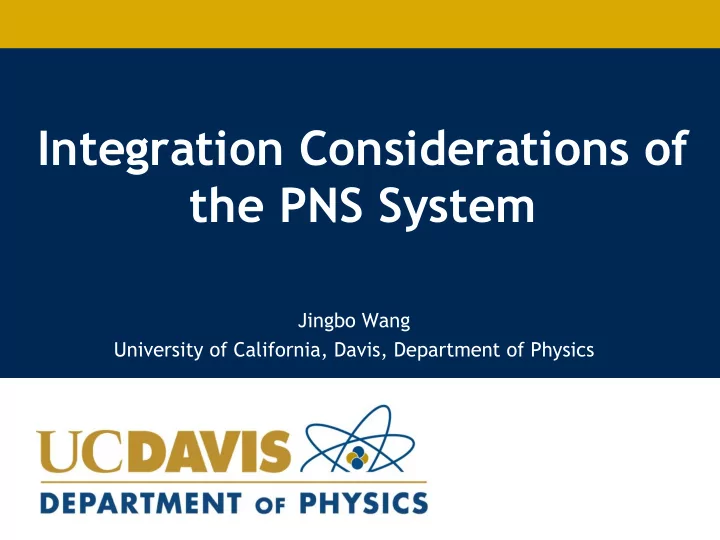

Integration Considerations of the PNS System Jingbo Wang University of California, Davis, Department of Physics
PNS System Location Plan for DUNE single phase far detector: Two corner manholes + one § possible middle feedthrough Two different types of penetration ports require different PNS designs § Human access Multi-purpose calibration Human access ports ports (manhole) feedthrough (manhole) DUNE calibration TF & consortium joint meeting Slide 2
Two PNS Designs § The entire system will be assembled and tested on surface Design A system will be installed after the human access ports are closed as it sits § above them. Design B system will be installed to the penetration feedthrough § An external dosimeter and a possible neutron monitor will be used to monitor the neutron yield and confirm the safety condition 25 cm Design B feedthrough Design A Location PNS Size [cm] Weight [kg] Neutron Extra Capture Yield Shield Design A Above manhole 80 OD × 105 H 1600 0.13% No Design B Inside 20 OD × 160 H 140 0.13% Yes feedthrough Could be portable DUNE calibration TF & consortium joint meeting Slide 3
Candidate DD Generator § nGen-300 model is a portable system and could be easily operated with batteries § All high voltage is contained within sealed generator § Connecting cable to power box is low voltage. http://www.starfireindustries.com/ DUNE calibration TF & consortium joint meeting Slide 4
Candidate DD Generator DUNE calibration TF & consortium joint meeting Slide 5
Space Requirements § Does your system require crane or forklift to move? What weight is the system? – Design A moderator is about 1.5 ton, so a crane is needed to move the entire neutron source to the injection locations – Design B moderator is about 140 kg, so a crane is not necessary § During operation, will your systems require motion on the cryostat? – Design A systems will be permanently deployed at the manholes, and no motion is needed during operation. – Design B system is portable and could be removed after operation. § Does your system require dedicated racks? If so, how many? Do racks require AC power? – One half rack is needed to operate the DD generator, based on the Super-K DT generator experience. AC power is required for non-battery mode – If we use the nGen-300 from Starfire, we could operate the DD generator with a battery DUNE calibration TF & consortium joint meeting Slide 6
Space Requirements § What are the space requirements around the cryostat flanges for your system? – We may need space for a table to place the control box and a computer, if remote control is not available. It’s better to operate the system from the control room. § Is mezannine an issue for your system (installation/operations- wise)? (note: only 2.1 m clearance under mezannine w.r.t. the top of the I-beam) – The height of the PNS moderator is less than 1.2 m. The 2.1 m clearance should be sufficient § Are I-beams an issue for handling/operating your system? – The I-Beam structure isn't an issue in terms of the system width. The system can be placed inside the I-Beam grid. It is expected that the entire PNS system (Design A) will be hang to the I-Beam to support the weight (~1.5 ton) DUNE calibration TF & consortium joint meeting Slide 7
Infrastructure Requirements § Rack power requirements? – The power to operate the nGen-300 DD generator is very low: 400 W – The required HV is 150 kV § What’s the cable type and length? – Only a control cable for the DD generator is needed. The cable will run from the sealed DD generator tube to the control box. There will be no cable going into the cryostat. – In Super-K, the DT generator cable runs about a few tens of meter. It’s expected that the nGen-300 DD generator will come with a cable that can be customized (need to be confirmed by the vendor) § Is network needed? – No necessarily, but it would be good to have network for remote control and monitor of the neutron yield. DUNE calibration TF & consortium joint meeting Slide 8
Many Other Questions § The following list is the example of directory/file structure that will have to sit in EDMS for each consortium (suggestion from TC): 1) 3D models 2) Part drawings 3) Production documents 4) Grounding diagram 5) System Level block diagrams 6) Wiring diagrams 7) Printed Circuit boards 8) Cable and Wire documentation 9) Interface documents 10) Engineering notes We will focus on the ARTIE experiment in fall 2019. The mechanical design of the PNS system is expected to start after ARTIE is done. DUNE calibration TF & consortium joint meeting Slide 9
Import Milestones § ARTIE at LANL Fall 2019 § PNS design decision March 2020 § PNS design review April 2020 § Moderator construction Spring 2020 § Moderator assemble & test 2020 § Start of ProtoDUNE-II installation (SP and DP) March 2021 § ProtoDUNE test Summer 2021 § Start of PNS production May 2022 § End of PNS production March 2023 DUNE calibration TF & consortium joint meeting Slide 10
Backup DUNE calibration TF & consortium joint meeting Slide 11
Super-K DT Generator DUNE calibration TF & consortium joint meeting Slide 12
Recommend
More recommend